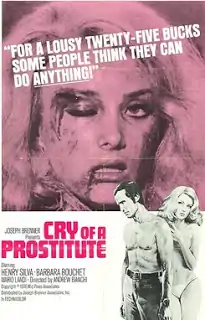| Cry of a Prostitute | |
|---|---|
 | |
| Directed by | Andrea Bianchi |
| Screenplay by | Piero Regnoli[1] |
| Story by | Sergio Simonetti[1] |
| Produced by | Mauro Righi[1] |
| Starring | |
| Cinematography | Carlo Carlini[1] |
| Edited by | Otello Colangeli[1] |
| Music by | Sante Maria Romitelli[1] |
Production company | Alexandra Cinematografica Internazionale[1] |
| Distributed by | Variety Distribution |
Release date |
|
| Country | Italy[1] |
| Box office | ₤444 million |
Cry of a Prostitute (Italian: Quelli che contano, also known as Love Kills and Guns of the Big Shots) is a 1974 Italian gangster film directed by Andrea Bianchi.[2][3][4]
Plot
Hitman Tony Aniante returns to his native Sicily after having spent many years in the United States. Upon his arrival, the rival families Cantimo and Scannapieco contend for his services, unaware that Aniante's plan is actually to pit one against the other in order to take power, for which a reformed prostitute joins forces with him.
Cast
- Henry Silva as Tony Aniante
- Barbara Bouchet as Margie
- Fausto Tozzi as Don Ricuzzo
- Vittorio Sanipoli as Don Cascemi
- Patrizia Gori as Carmela
- Dada Gallotti as Santa Scannapieco
- Mario Landi as Don Turi Scannapieco
- Alfredo Pea as Zino
- Carla Mancini as Margie's Maid
Production
Cry of a Prostitute was filmed at Incir-De Paolis in Rome and on location in Savona.[1]
Release
Cry of a Prostitute was released on 11 January 1974 in Italy, where it was distributed by Jumbo.[1] The film grossed a total of 444,963,000 Italian lire.[1] The film was released on VHS as Cry of a Prostitute: Love Kills and on DVD by Televista.[1] The Televista release is cut to 86 minutes.[1]
Reception
Austin Fisher in Blood in the Streets: Histories of Violence in Italian Crime Cinema wrote that the film was one in a series of Italian film, alongside La mala ordina (The Italian Connection, also starring Henry Silva) and Milano rovente (Gang War in Milan) that featured "'fixers' travelling over from the USA to resolve problems in the Italian mafia" and "overtly position American practices as the epitome of efficient modernity, in contrast to outmoded Italian ways of conducting business."[5]
Notes
- 1 2 3 4 5 6 7 8 9 10 11 12 13 Curti 2013, p. 109.
- ↑ Roberto Chiti; Roberto Poppi; Enrico Lancia. Dizionario del cinema italiano: I film. Gremese, 1991. ISBN 8876059695.
- ↑ Marco Giusti (1999). Dizionario dei film italiani stracult. Sperling & Kupfer. ISBN 8820029197.
- ↑ Roberto Curti (2006). Italia odia: il cinema poliziesco italiano. Lindau, 2006. ISBN 8871805860.
- ↑ Fisher, Austin (2019). Blood in the Streets: Histories of Violence in Italian Crime Cinema. Edinburgh University Press. pp. 146–147. ISBN 9781474411745.
References
- Curti, Roberto (2013). Italian Crime Filmography, 1968-1980. McFarland. ISBN 978-0786469765.